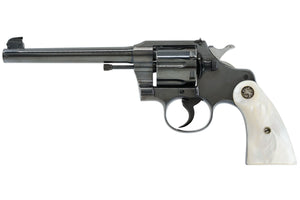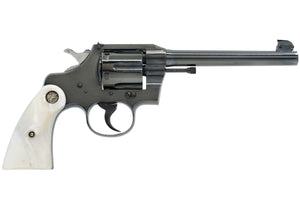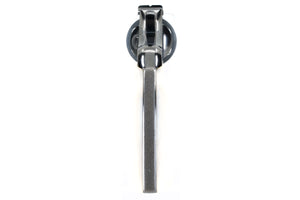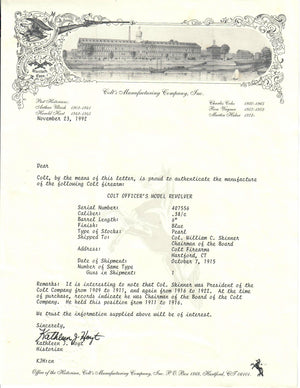OLD COLT: WE PROVIDE THE PUBLIC WITH AN ONLINE EDUCATIONAL RESOURCE FOR OLD COLT GUNS.
OLD COLT: WE PROVIDE THE PUBLIC WITH AN ONLINE EDUCATIONAL RESOURCE FOR OLD COLT GUNS.













This Colt Officers Model Revolver was Shipped to Col. William C. Skinner who was Chairman of the Board for Colt Firearms at the present time. It was delivered to him on October 7th, 1915 in a single sun shipment.
This particular revolver is finished in Colt's late high polish finish with pearl grips as indicated on the letter. Remarks on the letter include: It is interesting to note that Col. Skinner was President of the Colt Company from 1909 to 1911, and again from 1916 to 1922. At the time of purchase, records indicate he was Chairman of the Board of the Colt Company. He held this position from 1911 to 1916.
Colonel Skinner was born in Malone New York, January 26th 1855. After graduation from the Malone High School. Col. Skinner would travel to Hartford in 1872 and enrolled into the Trinity College which he graduated from in 1876. Later in life he would serve on the executive committee and as a Trustee. Post graduation he would then spend a few years at the Albany Law School. He would marry Florence Roberts on October 25th, 1880 and they would ultimately have three children. In 1882 he would enter the wool firm of Dwight, Skinner & Co. and remained until 1899.
Skinner would then become connected with Colt on July 2nd, 1901 when he was brought on to serve as the Vice President of the company and also occupied a board seat. On January 5th, 1909 he was elected president of Colt to succeed the late Lewis C. Grover. He would resign on January 1st, 1911 to regain the Vice President chair and Chairman of the board. Charles Robinson succeeded him as president but passed July 6th, 1916 and Colonel Skinner was called again to the direct the company. He would hold the president position again until he resigned on May 19th, 1921.
During Colonel Skinner's active connection with Colt it passed through two reorganizations, each of which left it in a stronger financial position and also made it capable of undertaking the U.S. Governments demands on production for the late war effort. Skinner was actively in charge of the affairs of Colt during the war and the strain placed upon him by this responsibility would tax his physical strength and and mental nerves. His two sons and son-in-law were in active service during the war but this was not realized by him until the war had ended resulting in a nervous breakdown. He never truly recovered from this and his health would continue to degrade over time.
He would end up serving on multiple boards during his career including director and Chairman of the board for the Colt's Patent Fire Arms Manufacturing Company; Director of the Connecticut Mutual Life Insurance Company; a Director of the Hartford Fire Insurance Company; The Hartford Accident and Indemnity Company; The Phoenix National Bank; A Vice-President of the Society for Savings; A trustee of the Fidelity Trust Company; A Director of the Smyth Manufacturing Company; A Director of Jay O. Ballard & Co. of Malone N.Y. and a Director for the Hartford Hospital.
Col. Skinner passed away at the age of 67 in 1904 and was still serving as the Chairman of the Board of Directors at the time. William Converse Skinner was the man at Colt who was responsible for working with Browning for the adoption of the M1911 pistol for the U.S. Government. He served as President of Colt during the final trials / acceptance period and then again previous to, during and post World War I. It's said that the M1911 changed the outcome of WWI because of it's ability to quickly reload and the use of the large caliber .45ACP cartridge. Without Col. Skinner at the helm of Colt during this period the outcome of the war may have been very different.
Col. William C. Skinner's Personal Government Model from 1913 can be seen here.